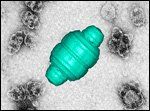Researchers at UCLA to Use Nanoscale Vaults in Treating Lung Cancer
Researchers at UCLA have engineered “vaults,” barrel-shaped nanoscale capsules found in the cytoplasm of mammalian cells, to slowly release chemokine CCL21 into tumors. CCL21 is a protein that, in pre-clinical studies in mice with lung cancer, stimulated the immune system to recognize and attack the cancer cells.
Researchers at UCLA have engineered “vaults,” barrel-shaped nanoscale capsules found in the cytoplasm of mammalian cells, to slowly release chemokine CCL21 into tumors. CCL21 is a protein that, in pre-clinical studies in mice with lung cancer, stimulated the immune system to recognize and attack the cancer cells, said Leonard Rome, a researcher at UCLA’s Jonsson Comprehensive Cancer Center, associate director of the California NanoSystems Institutes and co-senior author of the study, which appeared in PLoS yesterday, May 3rd, 2011.

UCLA scientists have discovered a way to wake up the immune system to fight cancer by delivering an immune system-stimulating protein in a nanoscale container called a vault directly into lung cancer tumors, harnessing the body's natural defenses to fight disease growth.
“Researchers have been working for many years to develop effective immune therapies to treat cancer, with limited success,” said Rome, who has been studying vaults for decades. “In lung tumors, the immune system is down-regulated and what we wanted to do was wake it up; find a way to have the cancer say to the immune system, ‘Hey, I’m a tumor and I’m over here. Come get me.’ ”
This new delivery system is based on an ongoing research effort led by UCLA’s Steven Dubinett that uses a patient’s white blood cells to create dendritic cells, which process antigen material and present it on the cell surface to other immune system cells. A Phase I study used a replication-deficient adenovirus to infect the dendritic cells and prompt them to over-secrete CCL21; the first time the chemokine has been administered to humans. The engineered cells were then injected directly into patients’ lung cancer and boosted the immune response, while showing no side effects. However, this process is cumbersome, expensive, and time-consuming: It takes more than a week to differentiate patients’ white blood cells into dendritic cells and allow them proliferate to the millions required for the therapy.
In addition to potentially being a less time-consuming course of treatment, the vault nanoparticles containing the CCL21 have been engineered to slowly release the protein into the tumor over time, producing an enduring immune response. The vault would require only a single injection into the tumor because of this slow-release design, and it eventually could be designed to be patient-specific by adding the individual’s tumor antigens into the vault. The vaults may also be targeted by adding antibodies to their surface that recognize receptors on the tumor. The injection could then be delivered into the blood stream and the vault would navigate to the tumor, a less invasive process that would be easier on the patients. The vault could also seek out and target tumors and metastases too small to be detected with imaging. Finally, because a vault is a naturally occurring particle, it causes no harm to the body and may be an ideal vehicle for use in delivery of personalized therapies.
The researchers plan to test the vault delivery method in human studies within the next three years and hope the promising results found in the pre-clinical animal tumor models can be replicated. Rome cautioned that the vault work is at a much earlier stage than Dubinett’s dendritic cell research, but he is encouraged by the early results. “In animals, the vault nanoparticles have proven to be as effective, if not more effective, than the dendritic cell approach,” he said. “Now we need to get the vault therapy approved by the FDA for use in humans.”